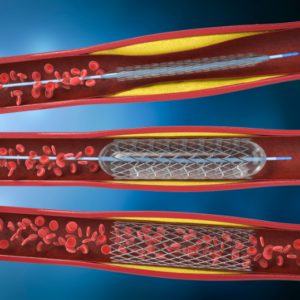- +91 83103 67685
- info@drameetoswal.com
- Basavanagudi
Angioplasty Doctor in Bangalore | Dr.Ameet Oswal says, Angioplasty is a kind of service that is invasive in nature and is to treat blocked arteries that restrict blood flow.

Get the Best Treatment for Angioplasty by our Best Angioplasty Doctor in Bangalore | Dr. Ameet Oswal. Angioplasty is a medical treatment used to open-up narrow or blocked blood vessels. The procedure is performed by inserting a small, hollow tube called a catheter through the vessel that is guided to the location of the blockage. Once in place, wire is passed into the blocked artery and then a balloon catheter is placed against the block and the balloon is inflated, which spaces the vessel and restores blood flow, lastly an Drug Eluting stent is placed. Cardiologists use angioplasty to treat a number of conditions, including heart disease, peripheral artery disease, and renal artery disease.

Angioplasty Doctor in Bangalore | Dr. Ameet Oswal says, Angioplasty is a treatment for Coronary Artery Disease (also known as CAD), which can be commonly understood as the blockage of arteries. You may be a good candidate for angioplasty if you have excess narrowing or blockage of a coronary artery, or you have symptoms of CAD. Some of the indications for that might be :
If you have any such symptoms, the doctor might suggest an angioplasty.
It is important to talk to your doctor pre-hand about any unusual symptoms you might be experiencing and also your treatment options. Some of the common symptoms can be:
Angioplasty is a type of minimally invasive procedure that is performed to unblock arteries and restore normal blood flow to heart or other organs of the body. This surgery is generally done under conscious or minor sedation. Narrowed or blocked arteries can cause heart attack, tissue failure, stroke, and even death if left untreated.
Angioplasty is a relatively short treatment process. The procedure lasts up to 30-60 minutes.
There are a few different cases where angioplasty can be used to unblock blood vessels. The two types are:
Cardiac angioplasty is where a cardiologist unblocks one or more arteries that are supplying blood to the heart muscle. The blockage of one or more arteries supplying the heart is commonly referred to as coronary artery disease.
Peripheral angioplasty is used to treat blockages in extremities of the body (i.e. arms and legs) and in some cases to enhance blood flow in kidneys.
Major complications after angioplasty are not at all common. Inserting the catheter used in angioplasty may injure the artery. There is also a small risk of blood clots, and blockages can relapse over time. A patient may also experience bleeding at the catheter insertion area and may need additional imaging or medical attention only if it worsens.
Recovery from angioplasty is typically brief. Work can usually be resumed a few days to a week after the procedure.
Subscribe our newsletter for latest information in the field of cardiology
WhatsApp us